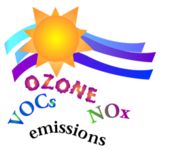
Ozone forms naturally in the upper atmosphere surrounding the Earth and protects life from the damaging ultraviolet light emitted by the sun. At ground level, the same ozone is harmful to living things; it is an air pollutant that damages human health, vegetation, and many man-made materials. Ground-level ozone is the key ingredient of urban smog. Ozone is mainly a daytime problem during the summer months because more sunlight and higher temperatures enhance ozone formation.
Ozone is not emitted directly into the air, instead it is created when gases called oxides of nitrogen (NOx) and volatile organic compounds (VOCs) react in sunlight and heat. Emissions of NOx are produced when fossil fuels are burned in motor vehicle engines, power plants, and industrial boilers. There are hundreds of thousands of VOC sources including automobile emissions, gasoline vapors, chemical solvents, and consumer products like paint.
Ozone affects your health when it is inhaled. Even at low concentrations, ozone can cause respiratory problems and aggravated asthma in children, people with respiratory diseases, and even otherwise healthy adults who are working or exercising outside on smoggy days. Children are most at risk from exposure to ozone because they are often active outside during the summer and their lungs are not fully developed. Long-term exposure to ozone may lead to premature aging of the lungs and chronic respiratory illnesses. Ground-level ozone is also responsible for 1 to 2 billion dollars of crop damage in the United States each year.

